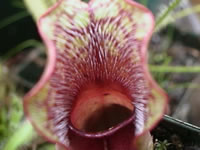North American Pitcher Plants
Sarracenia
Pitcher Plants should be grown in a mixture of live Sphagnum moss, medium orchid bark and charcoal. If you are unable to get any living Sphagnum moss, a mixture of peat moss and coarse builders sand will suffice.
|
|
Make sure the soil is kept very wet during the growing season, from May through October. Only rain water or distilled water should be used for watering carnivorous plants, and they should NEVER be fertilized... Pitcher Plants require a dormant cycle in the Winter. When active growth stops in late fall, clip off all of the dead or dying pitchers, leaving the smaller (still developing) pitchers. Keep them in an area that stays about 40 - 45 degrees for about 3 months, until new growth begins in the Spring. Pitcher Plants can be divided and repotted as the plant is coming out of dormancy, but this must be done before vigorous new growth begins. Most Pitcher Plant species are hardy in USDA zones 6-8, and may survive in even colder areas provided they are given a thick cover of winter mulch. They make excellent and interesting additions to any bog garden. |
Before you leave please read How to Grow Carnivorous Insectivores.
|
Search The Garden Helper:

